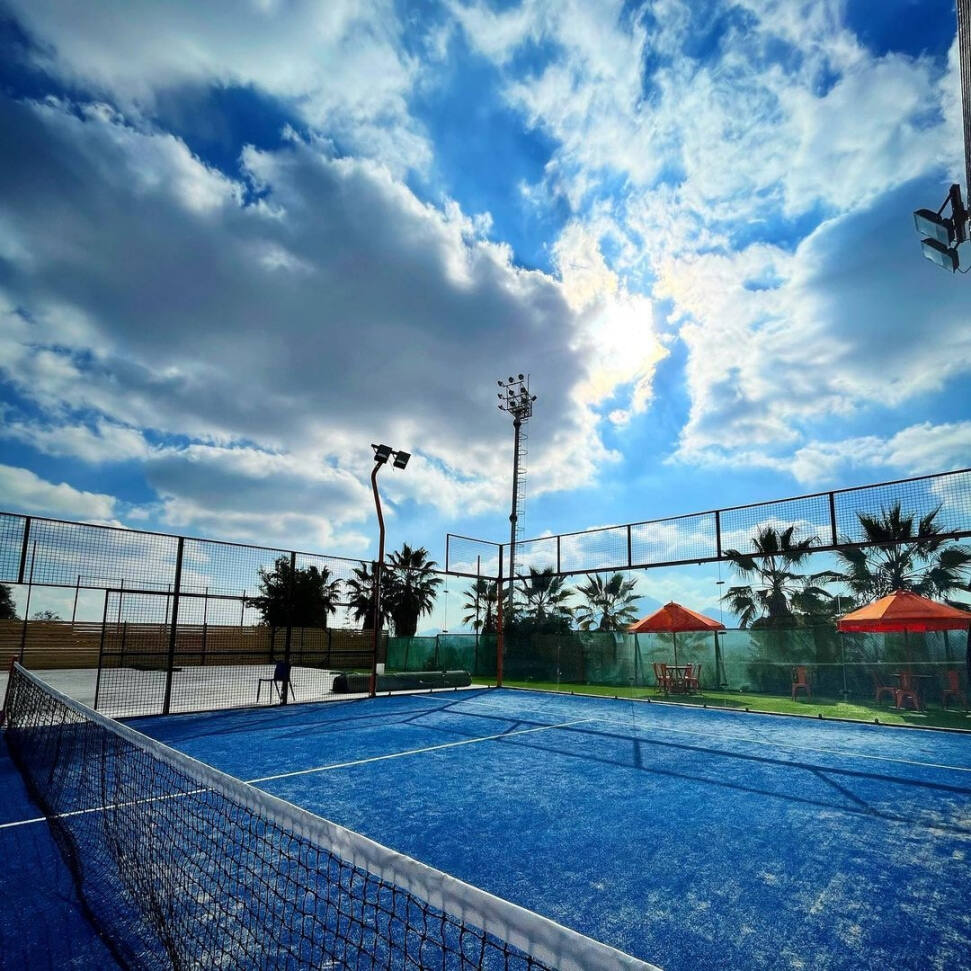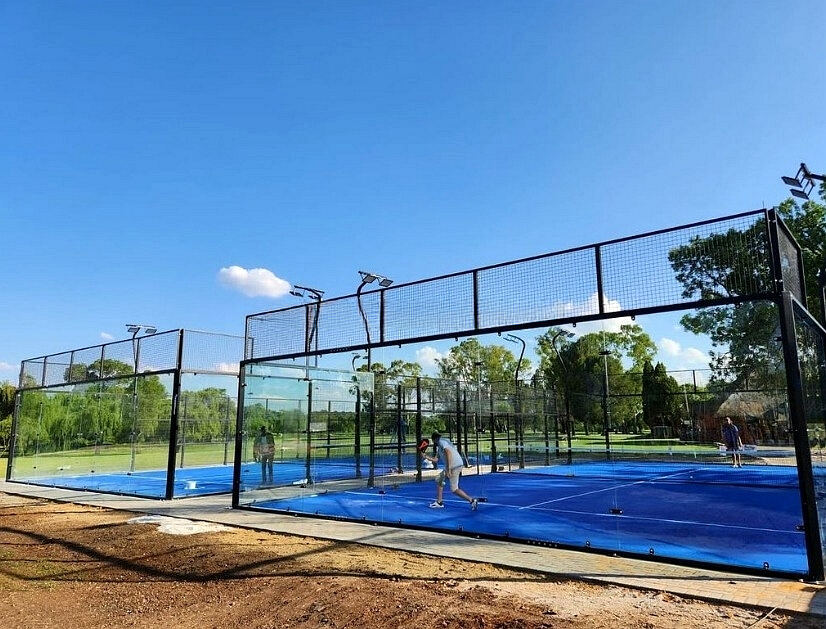Fans of racket sports may have noticed that Padel has gained in popularity worldwide in recent years. Played doubles, Padel blends elements from tennis and squash into its gameplay while possessing specific differences regarding its playing area, equipment, and type of court compared with tennis courts. Are You Curious How the Two Differ? Let's dive deeper into what distinguishes between them both and explore key distinctions that set each apart!

One of the first differences you'll notice between padel courts and standard tennis courts is size: A typical padel court is considerably smaller; typically measuring 20 meters long by 10 meters wide compared with 23.77-meter length and 8.23-meter width for standard courts, making padel much faster-paced as its ball frequently enters play with less time for players to react and react effectively.
Padel courts typically feature glass or solid walls which play an essential part of the game. Where in tennis a ball that hits a fence is considered out, but in padel players use its walls as part of its dynamics to bounce it back into play much like in squash - thus adding to its unique aesthetic and the dynamic nature of play. Glass walls create an interesting aesthetic and also increase dynamic aspects to this unique sport.
Equipment Options for Padel Racket Versus Tennis Racket: Padel Vs Tennis
Equipment used in both sports varies considerably as well. Tennis players use standard tennis rackets with strings that permit spinns and power shots while in padel, players use smaller solid perforated rackets made out of lightweight materials like carbon fiber or fiberglass that offer different feel and control than tennis rackets.
Padel is similar to tennis but uses a ball with slightly lower pressure; thus making the padel ball less lively on an ordinary tennis court; in contrast, due to padel's fast-paced nature it stays closer to the ground, keeping pace with faster play.
Padel is an exhilarating fast-paced game.
Padel is typically played as doubles, which involves four players on the court at once. Due to its smaller court and use of surrounding walls, padel tends to be faster-paced than traditional tennis due to players moving and reacting swiftly when fast returns come flying back at them - also adding another layer of strategy when hitting off walls adds another element. Rallies last much longer compared to quick points in tennis! This sport makes for exciting watching as well as play.
How Do Padel and Tennis Differ in Their Approach to Play

Padel and tennis may appear similar at first, yet their gameplay differ significantly. Padel introduces an entirely new dimension of play when using walls as part of its court, where balls may rebound off glasses or walls before hitting unexpected angles; players need a different strategy than when using traditional tennis racquets alone; plus teamwork between doubles players is more crucial in Padel due to a smaller court size and communication is vital!
Padel is an exciting combination of endurance and power that requires finesse and precision due to its small playing area and emphasis on angles and wall bounces, creating an unpredictable game which necessitates quick thinking and adaptation from players. This makes padel an engaging yet highly tactical sport!
Sports Court Installation and Sports Clubs.
Sports clubs worldwide are investing more and more in padel courts for installation in sports facilities worldwide, reflecting its popularity with players. More facilities now provide both tennis and padel courts on separate courts allowing easy switching between both activities; great News for anyone wanting to try both, since overlap in equipment required such as balls and rackets for both is minimal.
Some facilities, like SSTD Padel, specialize in creating high-quality padel courts to give clubs and their members an exceptional padel experience. Glass walls surrounding padel courts add visual interest while creating an interactive and captivating playing surface for spectators and players alike.
Conclusion of Padel's Proliferation in North America and Beyond (CCNAP).
Padel courts differ significantly from tennis courts in many ways, from size and equipment used, to pace of play and overall pace. While traditional tennis remains one of the world's most beloved sports, padel is quickly gaining ground across Europe, South America and North America due to its fast-paced action aided by strategically-placed walls which makes padel an exhilarating racket sport with which to engage - whether experienced tennis player or beginner! Giving it a go can provide new challenge!
Un Discover Padel at Your Local Sports Club
Many sports clubs now provide Padel courts, so why not give it a try? No matter your experience level with tennis or racket sports in general, padel is sure to prove both fun and engaging; perhaps after experiencing its thrills you might switch over from traditional tennis altogether?
Padel courts differ significantly from tennis courts beyond court dimensions alone; its distinctive setup - featuring glass walls and fast-paced action - offer sports enthusiasts an exciting new challenge. So next time you visit your local sports facility, why not give Padel a try - who knows it could become your new passion!?
Visit SSTD Padel for more information about installing padel courts and discover their wide array of sports facility services.
Are Padel Courts Differ From Tennis Courts? Fans of racket sports may have noticed that Padel has gained in popularity worldwide in recent years. Played doubles, Padel blends elements from tennis and squash into its gameplay while possessing specific differences regarding its playing area, equipment, and type of court compared with tennis courts. Are You Curious How the Two Differ? Let's dive deeper into what distinguishes between them both and explore key distinctions that set each apart!
One of the first differences you'll notice between padel courts and standard tennis courts is size: A typical padel court is considerably smaller; typically measuring 20 meters long by 10 meters wide compared with 23.77-meter length and 8.23-meter width for standard courts, making padel much faster-paced as its ball frequently enters play with less time for players to react and react effectively.
Padel courts typically feature glass or solid walls which play an essential part of the game. Where in tennis a ball that hits a fence is considered out, but in padel players use its walls as part of its dynamics to bounce it back into play much like in squash - thus adding to its unique aesthetic and the dynamic nature of play. Glass walls create an interesting aesthetic and also increase dynamic aspects to this unique sport.
Equipment Options for Padel Racket Versus Tennis Racket: Padel Vs Tennis
Equipment used in both sports varies considerably as well. Tennis players use standard tennis rackets with strings that permit spinns and power shots while in padel, players use smaller solid perforated rackets made out of lightweight materials like carbon fiber or fiberglass that offer different feel and control than tennis rackets.
Padel is similar to tennis but uses a ball with slightly lower pressure; thus making the padel ball less lively on an ordinary tennis court; in contrast, due to padel's fast-paced nature it stays closer to the ground, keeping pace with faster play.
Padel is an exhilarating fast-paced game.
Padel is typically played as doubles, which involves four players on the court at once. Due to its smaller court and use of surrounding walls, padel tends to be faster-paced than traditional tennis due to players moving and reacting swiftly when fast returns come flying back at them - also adding another layer of strategy when hitting off walls adds another element. Rallies last much longer compared to quick points in tennis! This sport makes for exciting watching as well as play.
How Do Padel and Tennis Differ in Their Approach to Play
Padel and tennis may appear similar at first, yet their gameplay differ significantly. Padel introduces an entirely new dimension of play when using walls as part of its court, where balls may rebound off glasses or walls before hitting unexpected angles; players need a different strategy than when using traditional tennis racquets alone; plus teamwork between doubles players is more crucial in Padel due to a smaller court size and communication is vital!
Padel is an exciting combination of endurance and power that requires finesse and precision due to its small playing area and emphasis on angles and wall bounces, creating an unpredictable game which necessitates quick thinking and adaptation from players. This makes padel an engaging yet highly tactical sport!
Sports Court Installation and Sports Clubs.
Sports clubs worldwide are investing more and more in padel courts for installation in sports facilities worldwide, reflecting its popularity with players. More facilities now provide both tennis and padel courts on separate courts allowing easy switching between both activities; great news for anyone wanting to try both, since overlap in equipment required such as balls and rackets for both is minimal.
Some facilities, like SSTD Padel, specialize in creating high-quality padel courts to give clubs and their members an exceptional padel experience. Glass walls surrounding padel courts add visual interest while creating an interactive and captivating playing surface for spectators and players alike.
Conclusion of Padel's Proliferation in North America and Beyond (CCNAP).
Padel courts differ significantly from tennis courts in many ways, from size and equipment used, to pace of play and overall pace. While traditional tennis remains one of the world's most beloved sports, padel is quickly gaining ground across Europe, South America and North America due to its fast-paced action aided by strategically-placed walls which makes padel an exhilarating racket sport with which to engage - whether experienced tennis player or beginner! Giving it a go can provide new challenge!
Un Discover Padel at Your Local Sports Club
Many sports clubs now provide Padel courts, so why not give it a try? No matter your experience level with tennis or racket sports in general, padel is sure to prove both fun and engaging; perhaps after experiencing its thrills you might switch over from traditional tennis altogether?
Padel courts differ significantly from tennis courts beyond court dimensions alone; its distinctive setup - featuring glass walls and fast-paced action - offer sports enthusiasts an exciting new challenge. So next time you visit your local sports facility, why not give Padel a try - who knows it could become your new passion!?
Visit SSTD Padel for more information about installing padel courts and discover their wide array of sports facility services.